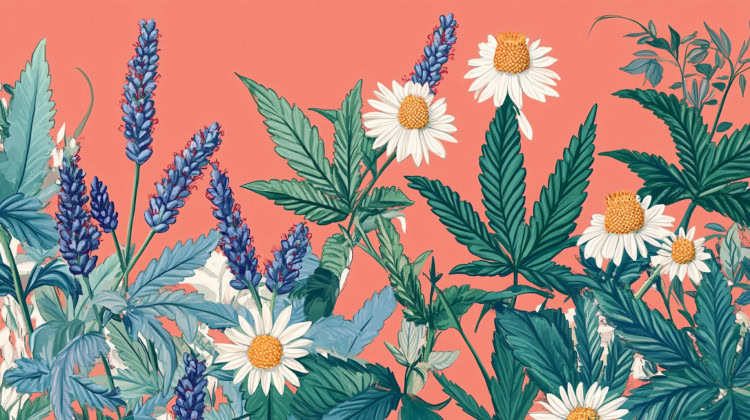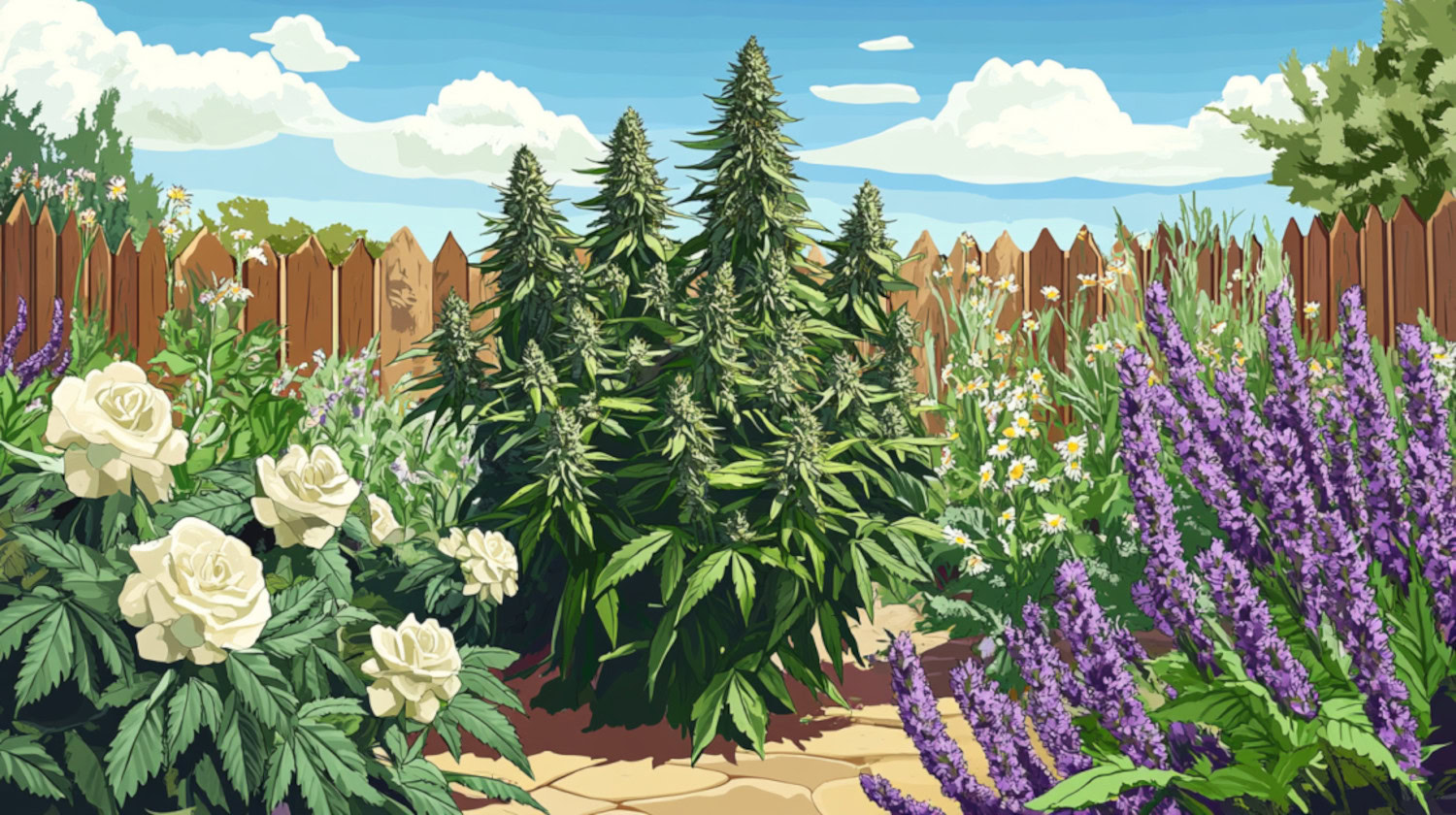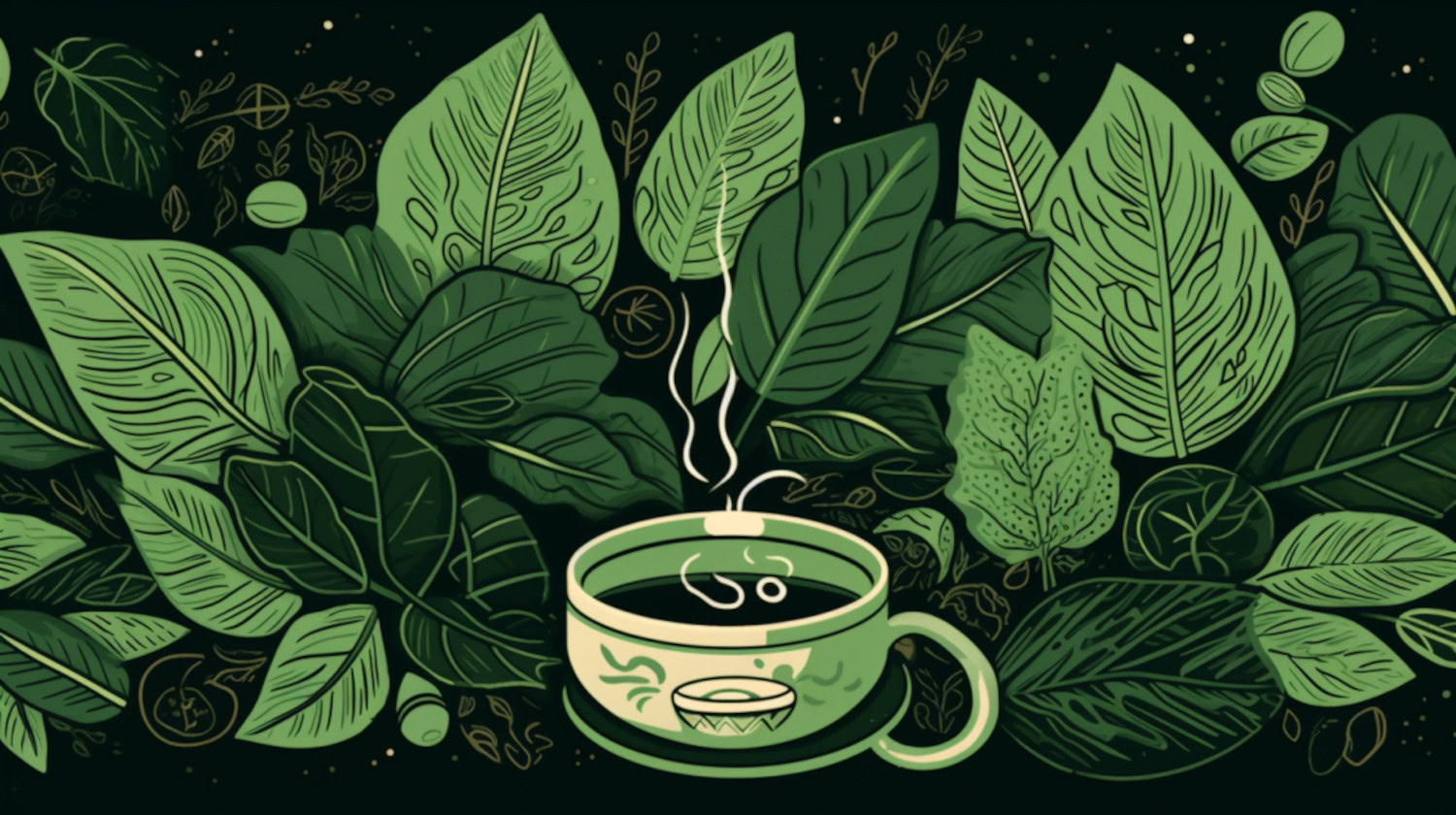In This Article
- Why Add Herbs to Cannabis?
- Herbs and Terpenes
- Enhancing Cannabis Effects
- Top Herbs to Smoke with Cannabis
- Lavender
- Peppermint
- Mugwort
- Marshmallow Leaf
- Mullein
- Rose Petals
- Passionflower
- Chamomile
- Holy Basil (Tulsi)
- Skullcap
- Calendula
- Thyme
- Clove
- Herbal Smoking FAQ
- Is Herbal Smoking Bad for You?
- What Herbs Are Good to Smoke for Anxiety?
- What Is the Healthiest Herb to Smoke?
- How Do I Smoke Herbal Blends?
- References
Key Takeaways
- Herbal smoking blends let you personalize your cannabis experience.
- Herbs share terpenes with cannabis, enhancing effects like focus or calm.
- Swap harsh fillers in herbal joints with smoother-tasting herbs for gentler sessions.
Looking to refresh your cannabis routine? Herbal smoking blends let you adjust your sessions, whether you want smoother smoke, specific effects, or to use less flower. Mix in lavender for relaxation, peppermint for a refreshing kick, or mullein to ease harshness. Here, we’ll break down the best herbs to combine with cannabis and how to get started.
Why Add Herbs to Cannabis?
Herbal smoking blends let you customize your cannabis experience. By combining cannabis with herbs, you can enhance its effects, create smoother smoke, and even reduce the amount of cannabis needed to achieve your desired results.
For example:
- Lavender adds a floral aroma and may promote relaxation.
- Peppermint offers a refreshing, cooling sensation and can soothe the throat.
- Lemon Balm provides a mild, uplifting buzz that pairs well with energizing strains.
These herbs also add variety to your sessions, making them more enjoyable and less harsh. Whether you want to relax, focus, or try something new, herbal blends allow you to personalize your experience.
Herbs and Terpenes
Terpenes are compounds that give plants their distinctive aromas and flavors. They also have many potential therapeutic benefits and contribute to the entourage effect. For instance, borneol, found in herbs like rosemary and lavender, may help cannabinoids cross the blood-brain barrier, potentially enhancing their effects.
Other terpenes, such as linalool (in lavender) and pinene (in basil and sage), are known for their calming and anti-inflammatory properties. You can create a more nuanced and effective experience by combining herbs rich in terpenes with cannabis.1
Enhancing Cannabis Effects

Some terpenes in herbs boost cannabinoid absorption. Borneol (in rosemary and lavender) helps cannabinoids cross the blood-brain barrier, increasing their effectiveness. Myrcene (in thyme and basil) may prolong the effects of THC by slowing its breakdown in the body.
Pair CBD-rich cannabis with calming herbs like chamomile (high in bisabolol) to improve anti-anxiety effects. Combining energizing strains with rosemary (pinene-rich) might sharpen mental clarity.
When rolling a joint, replace tobacco or cannabis filler with smoother herbs like mullein or marshmallow leaf to reduce harshness and stretch your cannabis supply. Make sure your herbs are organic and smoke-safe.
Top Herbs to Smoke with Cannabis

These are some of the best herbs to make your bud stretch further.
Lavender
Lavender’s fragrant purple buds have been used in Mediterranean aromatherapy for centuries to ease tension. Its high linalool content contributes to its calming reputation. When dried properly, it burns evenly, adding a floral sweetness to herbal blends.
Peppermint
Peppermint’s menthol helps cool the throat, creating a refreshing sensation. Its crisp aroma can mask harshness in smoke, but use it sparingly. Dried leaves burn hotter than fresh.2
Mugwort
Mugwort has deep roots in European and Asian folk medicine, where it was burned for spiritual cleansing and dream enhancement. Its slightly bitter smoke contains trace amounts of thujone, which is potentially neurotoxic and is a key component of absinthe, so moderation is important.
Marshmallow Leaf
Ancient herbalists relied on its high mucilage content to soothe throats.2 Slow-burning and subtly sweet, it stretches cannabis and pairs with fruity strains.
Mullein
Mullein’s velvety leaves have been smoked or brewed by Native American tribes to support respiratory health.2 Its mild, neutral flavor and fluffy texture make it ideal for balancing dense cannabis flower in joints.
Rose Petals
Dried rose petals, a staple in Middle Eastern ceremonial blends, add a subtle sweetness and visual appeal. To avoid mold in storage, make sure the petals are pesticide-free and fully dehydrated.
Passionflower
Passionflower’s intricate blooms were used by Aztec healers to promote rest. Its smoke is mildly sedative, with a grassy flavor that pairs well with earthy or floral cannabis terpenes.
Chamomile
Chamomile’s daisy-like flowers, sun-dried for herbal teas, contain bisabolol, a terpene also found in cannabis. Its smoke is subtly sweet and less harsh than many other herbs.
Holy Basil (Tulsi)
Revered in Ayurveda, tulsi is revered as a sacred adaptogen. Its peppery, clove-like smoke is believed to balance stress.2 Its sturdy leaves burn slowly, making it a practical addition to blends.
Skullcap
Skullcap has been found to have both anti-inflammatory and anti-viral properties. The plant's smoke is earthy and slightly bitter, best blended with sweeter herbs.3
Calendula
Calendula’s vibrant orange petals, often used in topical salves, add anti-inflammatory benefits and a golden hue to blends. Its mild, slightly tangy flavor complements fruity strains.
Thyme
A kitchen staple, thyme’s earthy smoke contains myrcene, a terpene shared with cannabis.2 Dry sprigs fully to avoid a grassy aftertaste.
Clove
Clove’s potent eugenol numbs the throat slightly and is historically used in dental remedies. Grind dried buds finely to prevent uneven burning, and pair them with spicy or woody flavors.4
Herbal Smoking FAQ

Is Herbal Smoking Bad for You?
Smoking any plant material can irritate the lungs, so moderation is key. Consider alternatives like vaporizing or brewing herbal teas if you have respiratory issues. Always source high-quality, organic herbs to avoid contaminants like pesticides.
What Herbs Are Good to Smoke for Anxiety?
Herbal blends that include lavender, chamomile, and lemon balm, known for their calming effects. Always consult your physician before treating a specific condition with herbs.
What Is the Healthiest Herb to Smoke?
There is no healthy herb to smoke because it's not healthy to smoke. If you choose to smoke anyway, then what you choose should depend on your needs and preferences. Lavender and chamomile are suitable for relaxation, while peppermint and lemon balm are better for energy and mood.
How Do I Smoke Herbal Blends?
Smoke your herbs in a glass pipe or roll them into a joint with natural papers. If the smoke is too harsh, moisten the herbs slightly or use a moisture control packet when in storage to keep them at optimal humidity for smoother puffs.
References
- Weston-Green K, Clunas H, Jimenez Naranjo C. A Review of the Potential Use of Pinene and Linalool as Terpene-Based Medicines for Brain Health: Discovering Novel Therapeutics in the Flavours and Fragrances of Cannabis. Frontiers in Psychiatry. 2021;12. doi:https://doi.org/10.3389/fpsyt.2021.583211 ↩︎
- Garg R, Kiran Dobhal, Singh A. Utilization of Medicinal Herbal Plants in the Management of Respiratory Conditions. IntechOpen eBooks. Published online December 16, 2024. doi:https://doi.org/10.5772/intechopen.1008176 ↩︎
- Chanchal DK, Singh K, Bhushan B, et al. An updated review of Chinese skullcap (Scutellaria baicalensis): Emphasis on phytochemical constituents and pharmacological attributes. Pharmacological Research - Modern Chinese Medicine. 2023;9:100326. doi:https://doi.org/10.1016/j.prmcm.2023.100326 ↩︎
- Kaur D, Chandrul KK. Syzygium aromaticum L. (Clove): A vital herbal drug used in periodontal disease. Indian Journal of Pharmaceutical and Biological Research. 2017;5(02):45-51. doi:https://doi.org/10.30750/ijpbr.5.2.9 ↩︎
The information in this article and any included images or charts are for educational purposes only. This information is neither a substitute for, nor does it replace, professional legal advice or medical advice, diagnosis, or treatment. If you have any concerns or questions about laws, regulations, or your health, you should always consult with an attorney, physician or other licensed professional.




